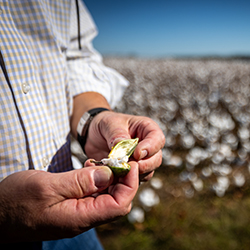This post is part of our blog series entitled “The Journey of Cotton.” This series will focus on the seven unique steps that it takes to process cotton, starting with the planting of the crop to the point it becomes a specific consumer product. We previously discussed growing cotton, but today’s post will focus on the second step in that journey: harvesting the cotton.
With Cotton Harvesting, Timing Is Everything
 Cotton is fully mature and ready for harvesting approximately 160 days after being planted. Once the bolls have burst open, the farmers can prepare the cotton plants for harvesting. This occurs in mid-July for the southern parts of Texas, and in early September for the northern parts of the cotton belt. One of the biggest threats to a cotton crop is weather—rain, specifically—so it must be harvested on time to avoid damage, which would negatively impact yield.
Cotton is fully mature and ready for harvesting approximately 160 days after being planted. Once the bolls have burst open, the farmers can prepare the cotton plants for harvesting. This occurs in mid-July for the southern parts of Texas, and in early September for the northern parts of the cotton belt. One of the biggest threats to a cotton crop is weather—rain, specifically—so it must be harvested on time to avoid damage, which would negatively impact yield.
Now, the Machines Do Much of the Work

Machines called cotton pickers are used to remove the bolls of cotton from the stalk. These machines use rotating spindles to pick (or twist) the seed cotton from the opened burr. Doffers then remove the seed cotton from the spindles. A second machine, called a cotton stripper, can also be used. This particular machine uses rollers equipped with bats and brushes to knock the open bolls from the plants into a conveyor. Both harvesting systems use air to elevate the seed cotton into a basket where it is stored until it can be dumped into a boll buggy.
Storing the Cotton Before Delivery to the Gin
Now that the cotton has been harvested from the field, it’s transferred from the boll buggy to a module builder. From there, the cotton is then packed into large cubes that weigh approximately 20,000 pounds each. At this point the cotton is sent to the cotton gin for processing and preparing before the fiber makes its next stop, which will be either a textile mill, or a purification manufacturer.
Up Next: Cotton Ginning
This is part three of our seven-part Journey of Cotton series. (If you missed our Introduction, be sure to visit that blog post.) The next step in the cotton journey is ginning, so keep an eye out on our blog for updates. You can also enter your email address in the “Stay in the Know” field in the right margin to have blog updates sent directly to your inbox.
